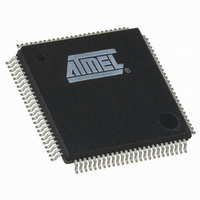AT91M40800-33AU Atmel, AT91M40800-33AU Datasheet - Page 58

AT91M40800-33AU
Manufacturer Part Number
AT91M40800-33AU
Description
IC ARM7 MCU 100 LQFP
Manufacturer
Atmel
Series
AT91SAMr
Specifications of AT91M40800-33AU
Core Processor
ARM7
Core Size
16/32-Bit
Speed
33MHz
Connectivity
EBI/EMI, UART/USART
Peripherals
POR, WDT
Number Of I /o
32
Program Memory Type
ROMless
Ram Size
8K x 8
Voltage - Supply (vcc/vdd)
1.8 V ~ 3.6 V
Oscillator Type
External
Operating Temperature
-40°C ~ 85°C
Package / Case
100-LQFP
Package
100TQFP
Device Core
ARM7TDMI
Family Name
91M
Maximum Speed
33 MHz
Operating Supply Voltage
2.5|3.3 V
Data Bus Width
32 Bit
Number Of Programmable I/os
32
Interface Type
EBI/USART
Number Of Timers
3
Processor Series
AT91Mx
Core
ARM7TDMI
Data Ram Size
8 KB
Maximum Clock Frequency
33 MHz
Maximum Operating Temperature
+ 85 C
Mounting Style
SMD/SMT
3rd Party Development Tools
JTRACE-ARM-2M, MDK-ARM, RL-ARM, ULINK2
Minimum Operating Temperature
- 40 C
Eeprom Memory
0 Bytes
Input Output
32
Interface
EBI/EMI, UART/USART
Ios
32
Memory Type
ROMless
Number Of Bits
32
Package Type
100-pin LQFP
Programmable Memory
0 Bytes
Timers
3-16-bit
Voltage, Range
1.8-3.6 V
Cpu Family
91M
Device Core Size
32b
Frequency (max)
33MHz
Program Memory Size
Not Required
Total Internal Ram Size
8KB
# I/os (max)
32
Number Of Timers - General Purpose
3
Operating Supply Voltage (typ)
2.5/3.3V
Operating Supply Voltage (max)
3.6V
Operating Supply Voltage (min)
1.8V
Instruction Set Architecture
RISC
Operating Temp Range
-40C to 85C
Operating Temperature Classification
Industrial
Mounting
Surface Mount
Pin Count
100
Lead Free Status / RoHS Status
Lead free / RoHS Compliant
Eeprom Size
-
Program Memory Size
-
Data Converters
-
Lead Free Status / Rohs Status
Lead free / RoHS Compliant
Available stocks
Company
Part Number
Manufacturer
Quantity
Price
Company:
Part Number:
AT91M40800-33AU
Manufacturer:
ATMEL
Quantity:
1 000
Company:
Part Number:
AT91M40800-33AU
Manufacturer:
ATMEL
Quantity:
346
Part Number:
AT91M40800-33AU
Manufacturer:
ATMEL/爱特梅尔
Quantity:
20 000
Hardware Interrupt
Vectoring
Priority Controller
Interrupt Handling
Interrupt Masking
58
AT91X40 Series
The hardware interrupt vectoring reduces the number of instructions to reach the inter-
rupt handler to only one. By storing the following instruction at address 0x00000018, the
processor loads the program counter with the interrupt handler address stored in the
AIC_IVR register. Execution is then vectored to the interrupt handler corresponding to
the current interrupt.
The current interrupt is the interrupt with the highest priority when the Interrupt Vector
Register (AIC_IVR) is read. The value read in the AIC_IVR corresponds to the address
stored in the Source Vector Register (AIC_SVR) of the current interrupt. Each interrupt
source has its corresponding AIC_SVR. In order to take advantage of the hardware
interrupt vectoring it is necessary to store the address of each interrupt handler in the
corresponding AIC_SVR, at system initialization.
The NIRQ line is controlled by an 8-level priority encoder. Each source has a program-
mable priority level of 7 to 0. Level 7 is the highest priority and level 0 the lowest.
When the AIC receives more than one unmasked interrupt at a time, the interrupt with
the highest priority is serviced first. If both interrupts have equal priority, the interrupt
with the lowest interrupt source number (see table 8) is serviced first.
The current priority level is defined as the priority level of the current interrupt at the time
the register AIC_IVR is read (the interrupt which will be serviced).
In the case when a higher priority unmasked interrupt occurs while an interrupt already
exists, there are two possible outcomes depending on whether the AIC_IVR has been
read.
•
•
When the end of interrupt command register (AIC_EOICR) is written the current inter-
rupt level is updated with the last stored interrupt level from the stack (if any). Hence at
the end of a higher priority interrupt, the AIC returns to the previous state corresponding
to the preceding lower priority interrupt which had been interrupted.
The interrupt handler must read the AIC_IVR as soon as possible. This de-asserts the
NIRQ request to the processor and clears the interrupt in case it is programmed to be
edge triggered. This permits the AIC to assert the NIRQ line again when a higher priority
unmasked interrupt occurs.
At the end of the interrupt service routine, the end of interrupt command register
(AIC_EOICR) must be written. This allows pending interrupts to be serviced.
Each interrupt source, including FIQ, can be enabled or disabled using the command
registers AIC_IECR and AIC_IDCR. The interrupt mask can be read in the read only
register AIC_IMR. A disabled interrupt does not affect the servicing of other interrupts.
ldr PC,[PC,# - &F20]
If the NIRQ line has been asserted but the AIC_IVR has not been read, then the
processor will read the new higher priority interrupt handler address in the AIC_IVR
register and the current interrupt level is updated.
If the processor has already read the AIC_IVR then the NIRQ line is reasserted.
When the processor has authorized nested interrupts to occur and reads the
AIC_IVR again, it reads the new, higher priority interrupt handler address. At the
same time the current priority value is pushed onto a first-in last-out stack and the
current priority is updated to the higher priority.
1354D–ATARM–08/02













